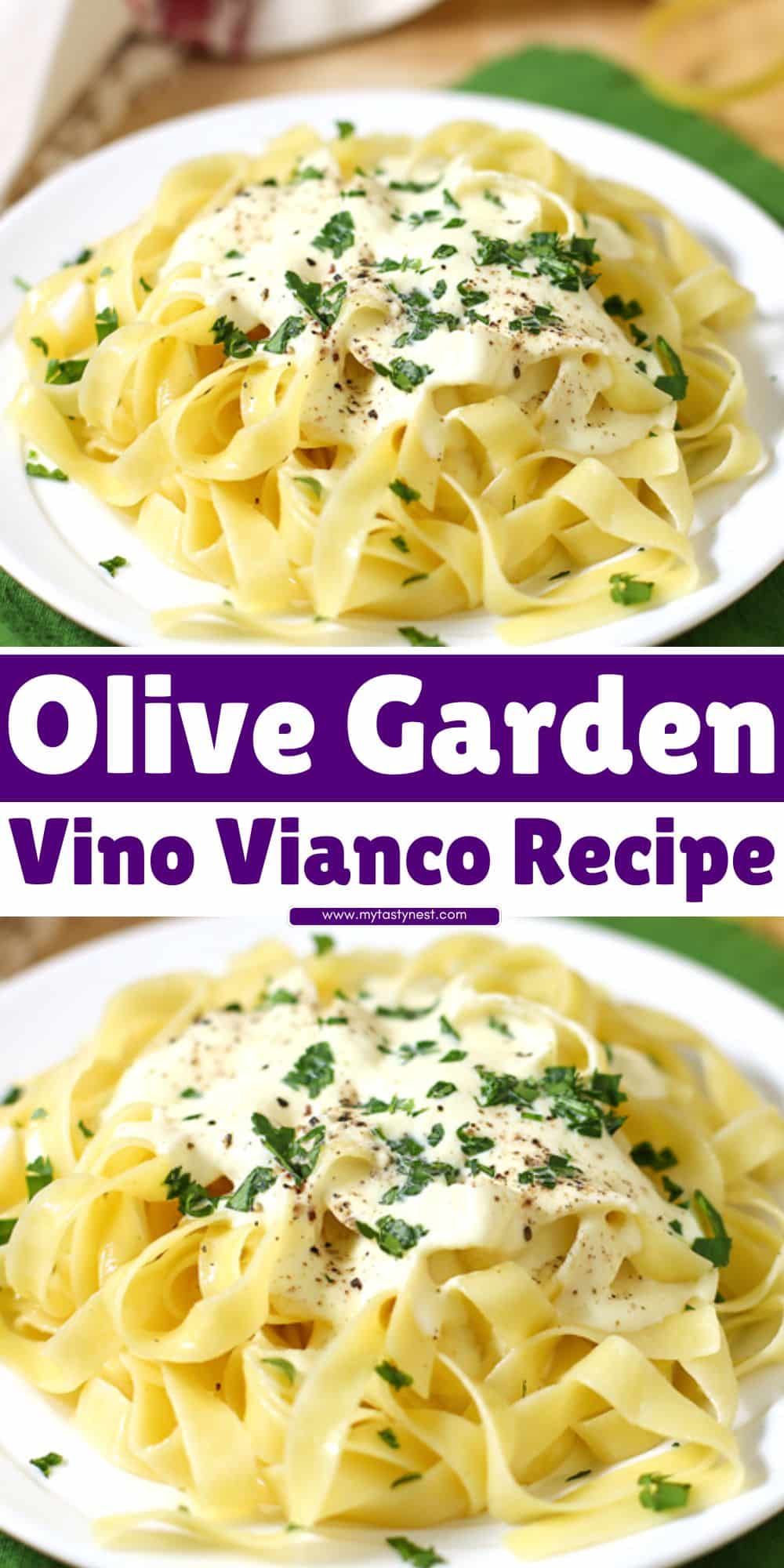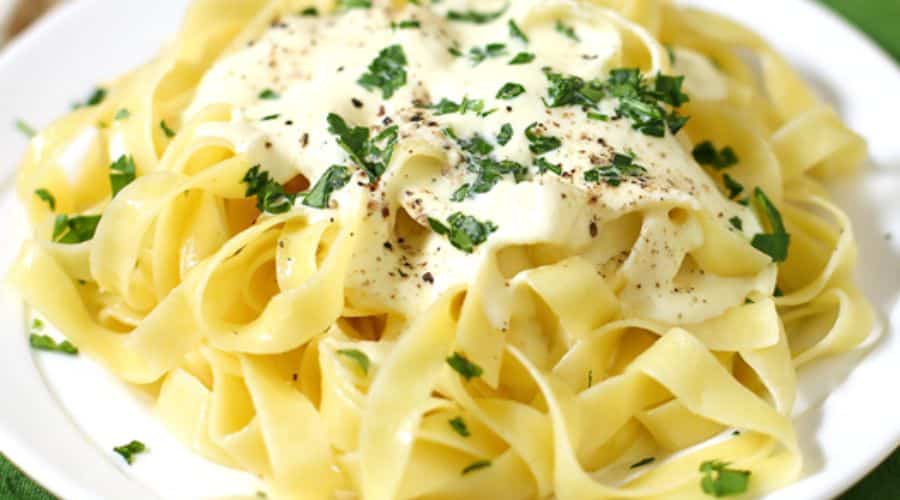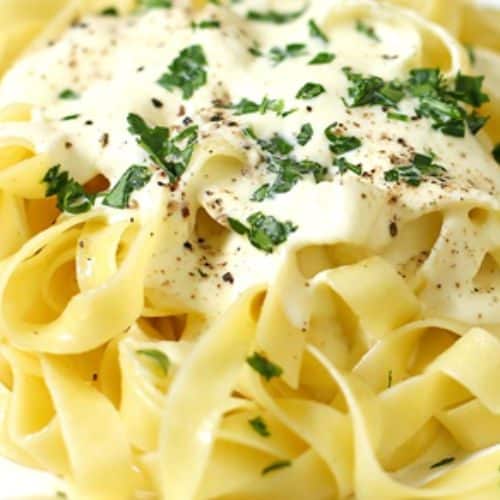Olive Garden is known for its flavorful and comforting Italian-inspired dishes, and one standout item on their menu is the Vino Bianco.
This rich, creamy dish captures the essence of classic Italian cuisine, combining the smoothness of white wine with a velvety cream sauce.
Served over pasta, seafood, or even grilled chicken, it’s a crowd-pleasing favorite.
Whether you’ve enjoyed it at the restaurant or are discovering it for the first time, recreating the Olive Garden Vino Bianco at home will bring a taste of Italy right to your kitchen.
In this blog post, we’ll guide you through every step of making this indulgent dish, along with tips on how to perfect the flavors and customize it to your preferences.
Get ready to elevate your dinner plans with this creamy, decadent white wine sauce that’s perfect for a special occasion or a weeknight treat.

What is Vino Bianco?
The term Vino Bianco directly translates from Italian as “white wine,” and it is often used in Italy to refer to dishes that feature this key ingredient.
In the context of this recipe, Vino Bianco is a creamy pasta dish where white wine plays an essential role in crafting the sauce.
The wine not only adds depth of flavor but also infuses the sauce with a subtle tang, balancing the richness of the cream and butter.
Traditionally, Vino Bianco is a simple yet sophisticated Italian recipe that highlights the elegance of white wine paired with fresh ingredients.
Olive Garden, however, has put its own twist on this dish, turning it into a hearty and comforting option that pairs wonderfully with pasta, shrimp, chicken, or even just a side of garlic bread.
The combination of garlic, shallots, white wine, and cream creates a velvety texture that coats your palate with every bite.
What makes this dish special is the balance of flavors — the slight acidity of the wine, the smooth creaminess of the sauce, and the seasoning that ties everything together.
It’s the kind of dish that feels both indulgent and refined, and you’ll be able to enjoy it in your own home with this easy-to-follow recipe.
Ingredients for Olive Garden Vino Bianco Recipe
To create this creamy and delicious Olive Garden Vino Bianco at home, you’ll need a few key ingredients that come together to make this dish both rich and flavorful.
While the recipe is simple, the quality of the ingredients will make all the difference.
Main Ingredients:
- Olive Oil: Used as the base for sautéing the garlic and shallots, adding a smooth, aromatic start to the sauce.
- Garlic (3 cloves): Freshly minced garlic is essential for bringing out that classic Italian flavor.
- Shallots (1 medium): Shallots provide a mild sweetness, offering a subtle depth of flavor that complements the garlic.
- White Wine (1 cup): Choose a dry white wine like Chardonnay or Pinot Grigio. This is the star of the dish, giving the sauce both acidity and complexity.
- Heavy Cream (1 cup): For that indulgent, silky texture that makes the sauce rich and smooth.
- Butter (2 tablespoons): Adds richness and enhances the overall flavor profile.
- Chicken Broth (1/2 cup): To balance the creaminess and provide a savory depth to the sauce.
- Parmesan Cheese (1/4 cup, grated): Freshly grated Parmesan is the finishing touch, adding a savory, nutty flavor to the sauce.
- Salt and Black Pepper: Season the sauce to taste with these basic pantry staples.
Optional Add-ins:
- Protein: You can customize this dish by adding grilled chicken, shrimp, or even lobster for a more luxurious meal.
- Pasta: Serve your Vino Bianco with pasta, such as fettuccine, linguine, or spaghetti, to make it a complete meal.
- Fresh Herbs: Garnish with freshly chopped parsley or basil for added color and fragrance.
With these ingredients on hand, you’re ready to start creating this indulgent dish at home!
Step-by-Step Instructions for Olive Garden Vino Bianco Recipe

Step 1: Sauté Garlic and Shallots
Begin by heating the olive oil in a large skillet over medium heat. Once hot, add the minced garlic and diced shallots to the pan.
Sauté for 2-3 minutes until the garlic becomes fragrant and the shallots soften. Be careful not to burn the garlic, as it can turn bitter.
Step 2: Deglaze with White Wine
Once the garlic and shallots are nicely cooked, it’s time to add the white wine. Pour in the wine and stir, scraping up any flavorful bits stuck to the bottom of the pan.
Allow the wine to simmer for 2-3 minutes, reducing slightly and infusing the sauce with its rich, tangy flavor.
Step 3: Add Cream and Butter
Lower the heat to medium-low and add the heavy cream and butter to the skillet. Stir until the butter melts completely and the cream begins to combine with the wine, creating a smooth and luscious sauce.
Step 4: Season the Sauce
Add the chicken broth to the skillet, followed by a pinch of salt and freshly cracked black pepper. Stir the mixture well and bring it to a gentle simmer.
Let it cook for another 3-5 minutes, allowing the sauce to thicken slightly and the flavors to meld together.
Step 5: Incorporate Parmesan Cheese
Stir in the grated Parmesan cheese, continuing to cook for another 1-2 minutes. The cheese will melt into the sauce, adding a rich, savory depth. Taste the sauce and adjust the seasoning, adding more salt or pepper as needed.
Step 6: Add Optional Protein or Vegetables
If you’re adding protein like grilled chicken or shrimp, now is the time to stir it in. For a more complete meal, toss in your cooked pasta (if using) or serve the sauce over the protein and veggies.
Let everything simmer together for a minute to ensure it’s heated through.
Step 7: Serve and Garnish
Once the sauce is ready and your protein or pasta is well-coated, it’s time to serve! Spoon the Vino Bianco over your pasta or plate it with your chosen protein. Garnish with freshly chopped parsley or basil for a burst of color and added flavor.
Tips for Perfect Olive Garden Vino Bianco
Creating the perfect Olive Garden Vino Bianco is all about balancing the flavors and getting the right texture.
Here are some helpful tips to ensure your dish turns out just like the restaurant version — or even better!
1. Choose the Right White Wine
The wine you select will significantly impact the flavor of your sauce. A dry white wine like Chardonnay or Pinot Grigio works best because it adds the necessary acidity without overpowering the dish.
Avoid sweeter wines, as they can throw off the balance of the sauce. Always choose a wine that you enjoy drinking, as the flavor will be prominent in the final dish.
2. Don’t Overcook the Garlic
Garlic cooks quickly, so be mindful not to let it brown or burn while sautéing.
Overcooked garlic can turn bitter and affect the flavor of the sauce.
A fragrant, golden-brown garlic base will add depth to the dish without any bitterness.
3. Adjust the Creaminess to Your Taste
If you prefer a thicker, richer sauce, let it simmer longer to reduce and thicken.
On the other hand, if you prefer a lighter sauce, you can adjust by adding a little extra chicken broth or reducing the amount of heavy cream.
The beauty of this dish is that you can tailor the creaminess to your liking.
4. Use Freshly Grated Parmesan
For the best flavor and texture, use freshly grated Parmesan cheese instead of pre-shredded cheese.
Fresh Parmesan melts into the sauce better and adds a more complex, nutty flavor that’s integral to the dish.
5. Season Carefully
Taste the sauce throughout the cooking process and adjust the seasoning. The salt, pepper, and Parmesan all contribute to the flavor, so it’s important to balance them correctly.
A pinch of freshly cracked black pepper can bring out the natural flavors, and a little extra salt can elevate the richness of the sauce.
6. Serve Immediately
Like most creamy pasta dishes, Vino Bianco is best served right after it’s made.
The sauce may begin to thicken further as it cools, so be sure to plate it while it’s still fresh and warm.
Pairing Olive Garden Vino Bianco
The beauty of Olive Garden Vino Bianco lies in its versatility. This creamy, white wine-based dish pairs wonderfully with a range of wines and side dishes to create a complete and satisfying meal.
Best Wines to Pair with Vino Bianco
Since white wine is an essential component of the dish, it only makes sense to pair it with a similar white wine.
Here are some excellent wine pairing options:
- Chardonnay: A crisp, buttery Chardonnay complements the creamy richness of the Vino Bianco sauce. Choose one that has a good balance of oak and acidity.
- Pinot Grigio: For a lighter pairing, Pinot Grigio offers a fresh, crisp acidity that will contrast nicely with the richness of the sauce without overpowering it.
- Sauvignon Blanc: If you prefer a wine with more herbal notes, Sauvignon Blanc adds a zesty, citrusy flavor that pairs well with the garlic and shallots in the dish.
- Vermentino: An Italian white wine, Vermentino has a delicate and refreshing profile with hints of herbs and citrus, making it an ideal pairing with Italian cuisine like this.
Side Dish Pairings
A few well-chosen sides can elevate your meal and complement the richness of the Vino Bianco:
- Garlic Bread: A classic pairing with any pasta dish, garlic bread provides the perfect balance of crunch and buttery goodness to soak up the creamy sauce.
- Caesar Salad: A crisp Caesar salad with a tangy dressing helps cut through the richness of the sauce and adds a refreshing contrast.
- Roasted Vegetables: Roasted vegetables such as asparagus, zucchini, or bell peppers add texture and flavor that complements the creamy, savory notes of the Vino Bianco.
- Grilled Shrimp or Chicken: If you haven’t already added protein to the dish, grilled shrimp or chicken make excellent accompaniments. Their smoky, savory flavors pair beautifully with the creamy sauce.
How to Store and Reheat Leftovers
If you happen to have any leftovers of your delicious Olive Garden Vino Bianco, don’t worry!
This dish stores well and can be enjoyed the next day with just a little effort to reheat it.
Storing Leftovers
Once your Vino Bianco has cooled to room temperature, transfer it to an airtight container. Store it in the refrigerator for up to 3 days.
If you’ve added any protein (like chicken or shrimp) or pasta, be sure they are stored together in the same container.
If you’re storing only the sauce, it can be kept separately for better freshness.
Freezing Leftovers
While this dish can be frozen, it’s important to note that the cream-based sauce may change texture once thawed.
If you choose to freeze it, transfer the cooled leftovers to a freezer-safe container and store them for up to 1 month.
When you’re ready to enjoy it again, allow it to thaw in the refrigerator overnight before reheating.
Reheating Leftovers
To reheat, it’s best to use a stovetop rather than the microwave to prevent the sauce from becoming too thick or separating.
Place the leftovers in a saucepan over low to medium heat. Add a splash of chicken broth or a bit of cream to loosen up the sauce as it warms.
Stir occasionally to ensure the sauce reheats evenly without curdling.
If you prefer the microwave, heat in short intervals, stirring between each, until the dish is thoroughly warmed.
Conclusion
Recreating Olive Garden Vino Bianco at home is easier than you might think, and the results are absolutely worth the effort.
With a few simple ingredients, a little attention to detail, and the right techniques, you can enjoy this creamy, flavorful dish in the comfort of your own home.
Whether you’re cooking it for a special occasion, a cozy weeknight dinner, or just because you’re craving something rich and indulgent, this recipe brings the authentic flavors of Olive Garden right to your table.
Paired with a crisp white wine, some delicious sides, and a fresh salad, it makes for a memorable meal.
Don’t forget to enjoy it right away or store any leftovers for another indulgent meal!
With these tips and tricks, you’re sure to impress your guests or simply treat yourself to a comforting plate of Vino Bianco whenever you desire.
Frequently Asked Questions (FAQs)
1. Can I use any type of white wine for the recipe?
It’s best to choose a dry white wine, like Chardonnay or Pinot Grigio, for the perfect balance of acidity and flavor.
Avoid sweet wines, as they could overwhelm the sauce’s delicate flavor. A wine you would enjoy drinking will usually work best in the dish.
2. Can I make this recipe ahead of time?
Yes! You can make the Vino Bianco sauce ahead of time, but it’s best to store the sauce separately from the pasta or protein.
To reheat, simply follow the reheating instructions above to maintain the sauce’s smooth texture.
3. How do I make this recipe gluten-free?
To make this dish gluten-free, simply substitute the pasta with a gluten-free version.
There are many options available, such as rice pasta or gluten-free fettuccine, which will work perfectly with the Vino Bianco sauce.
4. Can I use milk instead of heavy cream for a lighter version?
While you can substitute milk for heavy cream, the result will be a thinner, less creamy sauce.
If you want to lighten the dish without sacrificing the creaminess, consider using half-and-half or a lighter cream alternative, but note that it may still lack the richness of heavy cream.
5. How can I make this recipe vegetarian?
To make a vegetarian version of the Vino Bianco, skip the chicken or shrimp and use vegetable broth instead of chicken broth.
You can also add in more vegetables, such as sautéed mushrooms, spinach, or roasted bell peppers, to make it more hearty and satisfying.

Olive Garden Vino Bianco
Equipment
- 1 large skillet (for sautéing and cooking the sauce)
- 1 Wooden Spoon or Spatula – For stirring
- 1 measuring cup (for measuring the wine and cream)
- 1 knife (for chopping garlic and shallots)
- 1 cutting board (for chopping ingredients)
- 1 grater (for grating Parmesan cheese)
Ingredients
- 2 tablespoons olive oil
- 3 cloves garlic minced
- 1 medium shallot diced
- 1 cup white wine dry white wine like Chardonnay or Pinot Grigio
- 1 cup heavy cream
- 2 tablespoons butter
- 1/2 cup chicken broth
- 1/4 cup grated Parmesan cheese
- Salt to taste
- Black pepper freshly cracked, to taste
Instructions
Step 1: Sauté Garlic and Shallots
- Heat olive oil in a large skillet over medium heat. Add minced garlic and diced shallots, sautéing for 2-3 minutes until fragrant and the shallots become soft and translucent. Be careful not to burn the garlic.
Step 2: Deglaze with White Wine
- Add 1 cup of white wine to the skillet, stirring to deglaze the pan. Let it simmer for 2-3 minutes, allowing the wine to reduce slightly and concentrate its flavors.
Step 3: Add Cream and Butter
- Lower the heat to medium-low. Stir in the heavy cream and butter, cooking for an additional 3-5 minutes until the butter has melted and the cream combines into a smooth, velvety sauce.
Step 4: Season the Sauce
- Add 1/2 cup of chicken broth to the sauce, and season with salt and freshly cracked black pepper. Stir well and let the sauce simmer for another 3-5 minutes, thickening slightly as the flavors meld.
Step 5: Add Parmesan Cheese
- Stir in 1/4 cup of grated Parmesan cheese, allowing it to melt into the sauce. Taste the sauce and adjust seasoning with additional salt or pepper if needed.
Step 6: Serve
- Once the sauce is thickened and creamy, serve it over your favorite pasta or protein, such as grilled chicken or shrimp. Garnish with freshly chopped parsley, if desired, and enjoy!
Notes
- Wine Selection: Use a dry white wine such as Chardonnay, Sauvignon Blanc, or Pinot Grigio. Avoid sweet wines as they can alter the flavor profile of the sauce.
- Cream: If you prefer a lighter version, you can replace the heavy cream with half-and-half or a lighter cream alternative, though this will change the texture.
- Protein Options: This sauce is versatile and can be served with grilled chicken, shrimp, or vegetables. If using shrimp, sauté them separately and add them to the sauce once it’s ready.
- Pasta Pairing: Serve the sauce with pasta varieties like fettuccine, linguine, or spaghetti, or even toss in roasted vegetables for a lighter, vegetarian version.
- Make Ahead: The sauce can be made ahead of time and stored in the fridge for up to 3 days. Reheat gently on the stovetop, adding a splash of broth or cream to restore the sauce’s smoothness.


